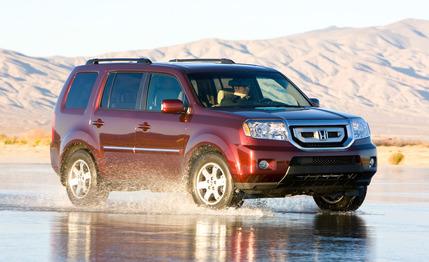 First Drive Review
First Drive Review
Honda consulted Pilot owners by the roomful before embarking on the redesign of its well-loved kid carter. From its rookie season in 2002 to now, the Pilot has stood out from its competition with smart handling and genius-level packaging. We have bestowed 5Best Trucks awards for eight years, and Pilots have earned six. Still, parents, the superdelegates among Pilot buyers, found a few things to crab about.
Make it roomier, especially in the third row, they said. The company obliged, adding 2.9 inches to the wheelbase and 1.9 inches to the third row’s legroom, now adult rated. The rear doors open wider, and the middle bench slides forward another two inches, giving way-back riders better access.
Give us a hand with fuel economy, Pilot owners said. Honda did what it could, revamping the 3.5-liter V-6 engine’s cylinder-cutoff system and adding 1 to 2 mpg to the EPA mileage numbers while nonetheless increasing the horsepower and torque figures slightly.
And whatever you do, pleaded the parents, don’t make the Pilot bulkier because it already barely fits around the piles of garage junk. Honda cut the roof height on front-drive versions by less than an inch but let length and width creep up 2.9 inches and 1.0 inch, respectively (with seats folded flat, the cargo area swallows four-foot-wide plywood sheets).
It should be noted that if fuel prices keep rising, the 2009 Pilot, on sale this month, could be the largest Honda SUV our market ever sees, says chief engineer Hiroshi Ito. A U.S. resident for 18 years and the only Japanese member of the Pilot’s otherwise all-American, Ohio-based, 300-member engineering squad, Ito says the new Acura MDX–based, eight-passenger Pilot has probably reached the size limit for its sales target (140,000 next year from Honda’s new plant in Lincoln, Alabama).
Meanwhile, the familiar shipping-box shape of the Pilot is carried forward but adds tension with a sharper chiseling of its lines and some pug-faced toughness in the thick bar of its grille. Extra steel body gussets around the door and liftgate holes, along with extensive deployment of high-strength steel, aim to make it a federal five-star crasher and improve bending and torsional stiffness. A multifingered crash structure up front is there to better disperse collision pulses over the entire body.
Cast aluminum control arms under the front struts and aluminum control arms and knuckles in the rear multilink suspension help maintain the old Pilot’s steering sharpness and body control and are curb-weight inflation fighters. Honda lists the new Pilot’s mass as 4300 to 4600 pounds depending on the configuration, or a roughly 50-to-75-pound gain. The latter number is due to a new Touring model, which starts at about $40,000 and adds navigation, a power liftgate, and a weighty sunroof that is 26 percent larger than the previous Pilot’s. The base Pilot should start at $28,000.
The standard five-speed automatic and optional VTM-4 all-wheel-drive system, using electronically clamped clutch packs, carries over largely unchanged. But the 3.5-liter SOHC 24-valve V-6 gets a cylinder-deactivation upgrade. To the engine’s previous V-6 and inline-three modes, Honda adds a V-4 mode—with the opposite outer pistons on both banks turned off—to fill a power gap between the other modes and increase the time the engine runs with inactive cylinders.
Before, the three cylinders could duck out only under light throttle and at lower speeds. Now, says Honda, with only two cylinders asleep, the Pilot can run to freeway speeds. The resulting vibration riot is smoothed over with electronically controlled engine mounts, an extra spring in the torque converter, and a noise-canceling system emitting through the radio speakers.
Aided by a two-stage magnesium intake manifold and a compression-ratio hike to 10.5:1, the V-6 delivers a 4500-pound towing capacity (a hitch receiver is standard) and perky throttle response while burning regular unleaded. Other notable new features include a telescoping steering wheel, a hill-holder function, and rear glass that flips up separately from the liftgate.
Thanks to the earnest complaining of previous Pilot owners, in the ’09 Pilot we find nothing to complain about.